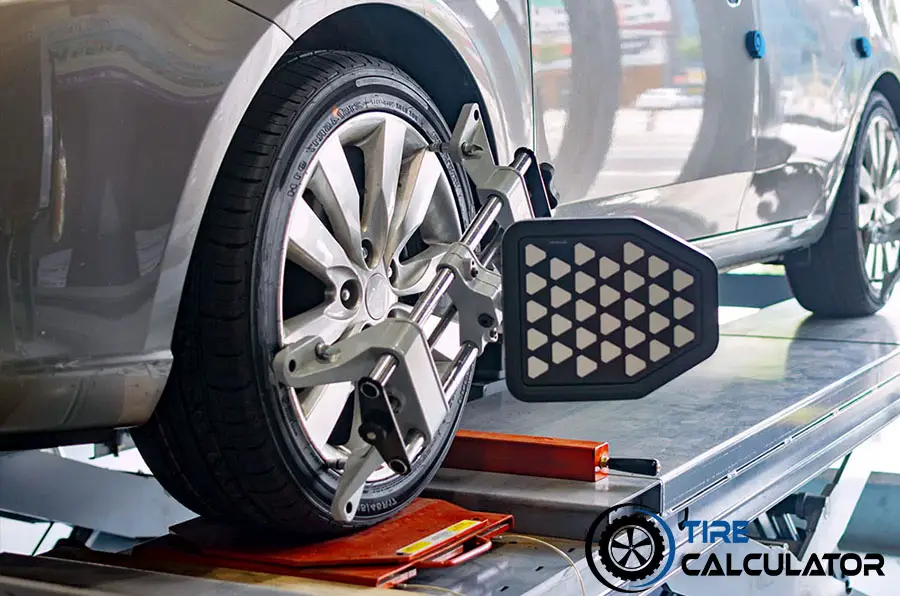It is a common inquiry: Do you need an alignment with four new tires? Although numerous experts recommend its use, few have the faintest idea about the necessity of an alignment. If you are in the same boat, this post is for you!
Do I Need An Alignment After Replacing Tires?
The answer is no. But we recommend doing so.
It is not compulsory to use the wheel alignment after your old tires have been replaced. However, its usage is suggested by many automotive specialists thanks to its angle-adjusting function.
If you find it difficult to understand, let’s dive deeper into what a wheel alignment is. This is an automobile maintenance device that manages the direction of your car wheels.
In other words, it helps all the steering wheels face the same direction by using camera units. They measure the physical positioning and compare the results with others attached to a central computer.
As such, it protects tires from premature wear and tears and consequently prolongs their lifespan. You also stand a good chance of avoiding a rough drive. Under a few circumstances, the angle outcome is used by the brand makers to track a vehicle’s handling characteristics.
How Could I Know My Car Requires An Alignment After New Tires?
The best way to determine is by considering the last time your car was serviced with a wheel alignment. You also need to estimate the total distance and evaluate the current conditions before concluding whether your car needs alignment.
So what are the conditions indicating that your car needs a new alignment? Below is a list for you:
- Your vehicle encounters a curb.
- There is uneven tire wear.
- The steering column shows a sign of sudden vibrating while you are disengaging the clutch.
- Excessive noise can be heard when the engine starts.
- Your car veers from side to side.
- A squealing sound pops up when your automobile turns right or left.
- The installation of a lift kit has just been completed.
- You make a replacement of steering or adjournment elements.
- Your vehicle gets stuck on the exterior edges with rounded damage.
- Suspension components impacting the tire angles are altered.
- The steering pull problem arises.
- Struts or shocks are worn out, causing atypical tire wear.
- The steering wheels are off-center or positioned inaccurately.
- A flapping noise appears, denoting the underinflated tires or something abnormal with the alignment rack.
How Often Does My Car Need Alignment?

If you have driven your car for 36,000 miles, or it is a year since your last alignment was performed, you are advised to do this task again.
Nevertheless, if the road conditions your vehicle rides daily is rough and bumpy, riddled with several hurdles, such as rocks or potholes, the time could be shortened, depending on your car’s state.
You should check the instruction manual of the brand to reap the optimal information. It would be best to tow your automobile to a reliable motor workshop for repair and maintenance.
Please don’t do it by yourself at home because premature damage to your tires due to improper alignment could be triggered.
Frequently Asked Questions
Is It Necessary To Have All Four Tires Aligned All At Once?
The answer is yes.
Getting a four-wheel alignment is highly recommended, and nearly all automotive vehicles today, such as cars, trucks, vans, or SUVs, also require it. Nonetheless, wheels of some models or types with metal axles based ahead only need to be aligned in the front.
But in every situation, professional mechanics always examine your car tires and related wear that compromises your car’s handling before deciding whether your vehicle is two-wheel or four-wheel aligned. So you don’t have to worry about this issue.
Should I Get New Tires Or An Alignment First?
It is up to you to align your wheels before or after installing new tires.
In fact, whichever comes first doesn’t matter because the worn-out tires only affect the ride height of your cars. In modern automobiles nowadays, the advanced design of suspension and steering is sophisticated, rendering the change trivial.
Why Does The Wheel Alignment Matter?
In addition to the above merits that an alignment brings, including greater protection, expanding tire life, and smoother drive experience, there are other advantages that could be enumerated.
For instance, you can save lots of money from the replacement cost. Misalignment also induces gas mileage reduction by 10%. Accordingly, the wheel alignment helps you conserve more fuel, and you don’t need to fill up frequently.
The Bottom Line
This post has offered a satisfying answer whether you need an alignment after replacing tires. Hopefully, you will grasp fundamental insights into this facet and know how to protect your car tires efficiently.
See more: what does XL mean on a tire?







